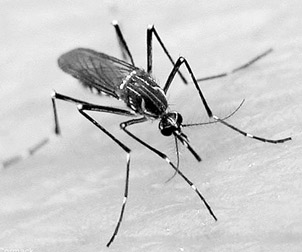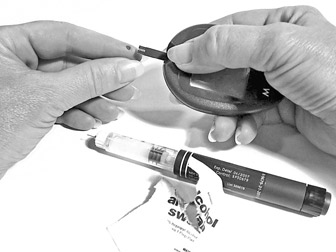|

Sharp decline in death rate:
Dengue menace begins at home
By Ananda KANNANGARA
 |
|
Dr.Paba Palihawadena |
Unlike other diseases, dengue has become a `household' word in the
country, due to the increase in number of patients from various parts of
the country.
There is no particular age group of those who contract Dengue
Haemorrhagic Fever (DHF), which has become an epidemic today. According
to reports the epidemic had originated in the urban sector and later
crept into rural and remote sectors in the country.
Although people tend to blame the Health Department for not taking
precautionary measures, it is not so as research studies indicate that
dengue cannot be controlled unless the country is rid of heaps of
garbage and dengue breeding grounds.
The Head of the Health Ministry's Epidemiology Unit, Dr. Paba
Palihawadana told the Sunday Observer that like several other diseases,
no proper medicine or vaccines have so far been found to treat dengue
patients.
She said destroying mosquitoes is the best way to be free of the
disease.
"It's not a hard job to destroy mosquitoes which are a common sight
in our environment.
If people clear thickets, heaps of garbage and culverts, destroy
discarded tyres, coconut shells and plastic bottles which litter their
home gardens, it will become an easy task to eliminate mosquito breeding
grounds.
Referring to the `Dengue Control Week' (DCW) program that was
launched by the Health Department Dr. Palihawadana said several programs
were also launched in the past by the Department to educate the health
authorities and the public, especially school children on the importance
of eliminating mosquito breeding places.
|

Dengue Fever spreads via bite of an infected dengue mosquito. |
There are similar programs such as the `National Dengue Eradication
Program' and the `Dengue Prevention Drive'. she said.
The Health Department's main intention is to educate people from the
grassroot-level as to how to combat the dengue menace.
"During this period we have conducted a large number of school
awareness programs in Colombo. The suburbs, urban areas and in the rural
sector with participation of children, parents and teachers,".
She said even in the city of Colombo mosquito breeding places were
found in home gardens and compounds of popular school, following raids
carried out by health officials recently.
Asked what action had been taken by the Health Ministry against local
Government institutions such as Divisional Secretariats. Pradeshiya
Sabhas and Provincial Councils for not taking proper steps to clear
garbage dumping grounds and also clear shrubs in their areas, Dr.
Palihawadana said a `National Steering Committee', (NSC) was appointed
by the Health Ministry to look into the outbreak of dengue in the
country.
She said senior officials, such as commissioners and directors
attached to varous departments and local government institutions are the
stakeholders in the NSC and it is their responsibility to keep their
areas clean.
She said 26 regional epidemiologists have also been appointed to MOH
offices countrywide including the most vulnerable areas such as Galle,
Kandy, Matara, Jaffna, Vavuniya, Kegalle, Matale, Kilinochchi and
Ratnapura to carry out dengue prevention campaigns.
According to statistics, 12,997 dengue patients were reported from
various parts of the country and 72 patients have died during the first
three months of this year.
She said due to the remarkable progress of the programs only three
deaths were reported in April.
At a glance
Patients Deaths
January 4,672 44
February 4,542 13
March 2,522 15
|
Dr. Palihawadana also said that 15 deaths were reported in the Jaffna
District during the first four months, 15 from Colombo and nine from
Batticaloa.
Asked about the Government's allocations to keep the countrywide
dengue eradication program alive, she said Rs. 500 million has already
been allocated and this will be utilised to purchase equipment and on
other related programs. She said the doctors are also following dengue
eradication training programs in Singapore and Thailand. Currently five
doctors are receiving training in Thailand. Dr. Palihawadana also said
that fever, headache, aches and pains and bleeding under the skin are
the main symptoms of dengue.
If such symptoms continue for about 3-5 days, patients must seek
treatments from a Government hospital since all state-owned hospitals
are fully equipped to treat dengue patients.
The Health Ministry has also strengthened the activities of the
Dengue Task Force (DTF) to eradicate the spread of the epidemic during
the coming rainy season this month and in June.
The DTF was initiated by the Health Ministry in February this year to
destroy dengue mosquito breeding grounds and the main task of the
program is to co-ordinate with relevant officials from grassroots level
and take precautionary measures to check the spread of the disease.
The DTF is Cabinet approved and has the authority to impose fines on
those who are found guilty of violating the Mosquito Breeding Control (MBC)
Act of 2009.
The DTF has also identified the countrywide dengue high risk zones in
the districts of Colombo, Kandy, Gampaha, Kegalle, Kurunegala, Matale,
Ratnapura, Puttalam, Hambantota, Kalutara, Trincomalee, Batticaloa and
Vavuniya.
Health Ministry Senior Epidemiologist Dr. Sudath Peiris said that it
is the sole duty of the public to engage in dengue eradication
activities from time to time in their home gardens and areas.
He said if every citizen in the country considers that eradicating
the mosquito menace is a national duty, the Government's Dengue
Eradication Program or even any other epidemic could be controlled
successfully.
He emphasised the importance of people from every state of society
cleaning the environemnt and also carrying out a proper garbage disposal
systems in their home gardens.
Dr. Peiris said that people could also use either mosquito repellents
that containing DEET or picaridin (KBR3020) or mosquito nets to get rid
of mosquitos.
******
[ Fact File]
Dengue is an acute flu-like fever caused by a virus. It can cause
disease in two forms:
(a) Dengue Fever (DF) - marked by an onset of sudden high fever,
severe headache, pain behind the eyes, and pain in muscles and joints.
Some may also have a rash.
(b) Dengue Haemorrhagic Fever (DHF) - is a more severe form, seen
only in a small proportion of those infected. Typically DHF is
characterised by high continuous fever for less than 7 days; bleeding
from various parts of the body (including nose, mouth and gums or skin
bruising) ; severe continuous abdominal pain mainly due to enlarged
liver, and shock in severe cases. This can lead to death.
DHF is more serious in children.
Transmission
Dengue Fever spreads via bite of an infected dengue mosquito. It can
spread fast in urban areas when the mosquitoes increase during rainy
season.
Clinical features:
We may all confuse dengue fever with flu or a cold. Clinical features
of dengue fever vary according to the age of the patient. Infants and
young children may have nonspecific febrile illness with rash. Older
children/adults may have a mild febrile illness or classical
incapacitating disease with abrupt onset and high fever, severe
headache, pain behind the eyes, muscle and joint pains, and rash.
1. Dengue Fever is a self limiting disease. For those who develop DHF
hospital treatment is required.
2. Patient may feel ill and fever may last up to a week. They could
feel weak and in low spirits for up to two weeks or so.
What you should really watch-out for are features of DHF.
Treatment:
There is no specific treatment for dengue fever. Treatment is
symptomatic - keep the person home and allow to rest, this will help
recover more quickly give plenty of fluids to drink allow to eat what
they can, Paracetamol may relieve symptoms of fever and joint pain.
Aspirin and other NSAIDs must be avoided.However, careful early clinical
management frequently saves lives of DHF patients.
It would be advisable to see a qualified doctor if you/your child has
high fever without any underlying reason for more than few days.
However, even if dengue fever is suspected, you may not be expected to
admit to a hospital.
Prevention and Control
DF is transmitted through a mosquito. Therefore, the best way to
avoid dengue infection is to prevent mosquito bites. Still there is no
vaccine or preventive drug. Hence, following tips are useful: Avoid
mosquito bites during day time by wearing protective clothing.
Use mosquito nets when sleeping (both day and night) Get rid of
mosquito breeding sites regularly in and around your household.These
usually are discarded tyres, plastic containers, coconut shells, leaf
axils, blocked roof gutters, bird baths flower vases, or any other place
where rain water collect.
If you/your child develop dengue fever try to be protected from
exposure to mosquito bites in order to avoid further spreading of the
infection. Especially children should stay at home during the illness,
ideally under a mosquito net when resting.
Courtesy:
Epidemiological Unit
******
Preventing diabetes and cardiovascular problems:
Healthy lifestyle, a must
by Dr. Yanushi Dullewe WIJEYERATNE BMBS (UK),
BMedSci Hons (UK)
 Diabetes and Cardiovascular problems are increasing worldwide at an
epidemic rate. Pre-diabetes (also referred to as impaired fasting
glucose or impaired glucose tolerance) may begin several years before
the clinical diagnosis of diabetes. Despite this, many people are
unaware of this condition and therefore, do little to slow its
progression at a reversible, early stage. Diabetes and Cardiovascular problems are increasing worldwide at an
epidemic rate. Pre-diabetes (also referred to as impaired fasting
glucose or impaired glucose tolerance) may begin several years before
the clinical diagnosis of diabetes. Despite this, many people are
unaware of this condition and therefore, do little to slow its
progression at a reversible, early stage.
Impaired glucose tolerance is a transitional state from
normoglycaemia to frank diabetes. Prior to the onset of type 2 diabetes,
people almost invariably have pre-diabetes. In this condition, the blood
glucose levels are higher than normal, but not yet high enough to be
diagnosed as diabetes. Unlike in diabetes, where fasting blood glucose
levels are greater than 7 mmol/L / 126mg/dL, people with pre-diabetes
have fasting plasma glucose levels from 6.1 to 6.9 mmol/L (110-125 mg/dL).
The progression from pre-diabetes to diabetes can be up to 50% over 10
years.
In the UK alone, there are 2.6 million people with diabetes, with an
estimated 7 million people having pre-diabetes.
The predisposing factors for developing impaired glucose tolerance
are similar to the risk factors for developing type 2 diabetes.
These comprise non-modifiable, constitutional risk factors such as
advanced age and a strong family history of diabetes, but also readily
modifiable risk factors including obesity, sedentary lifestyle and a
high-fat / high-carbohydrate diet. The progression to type 2 diabetes is
also influenced by these factors.
Similarly the pathogenesis of type 2 diabetes, the development of
pre-diabetes is initiated by resistance of target organs to insulin,
thereby reducing its action on the liver, muscles and adipocytes (fat
cells). As a result, a relative insulin deficiency develops. The
pancreas in turn attempts to increase insulin production, resulting in
an initial compensatory hyperinsulinaemia (excess levels of circulating
insulin in the blood). As diabetes progresses, insulin secretion from
the pancreas becomes defective, which further impacts on the glycaemic
control.
 There is substantial heterogeneity in the regulation of glucose
metabolism in individuals with impaired glucose tolerance. As a result,
the absolute risk of progression and subsequent development of diabetes
is difficult to predict for any single individual. It is however, known
that impaired glucose tolerance is indeed a major risk factor for the
development of type 2 diabetes. There is substantial heterogeneity in the regulation of glucose
metabolism in individuals with impaired glucose tolerance. As a result,
the absolute risk of progression and subsequent development of diabetes
is difficult to predict for any single individual. It is however, known
that impaired glucose tolerance is indeed a major risk factor for the
development of type 2 diabetes.
In addition to the considerably increased risk of developing
diabetes, people with impaired glucose tolerance are at an increased
risk of developing cardiovascular disease. Research has shown that some
long-term damage to the circulatory system, including the cerebral and
coronary blood vessels, begin to occur during pre-diabetes.
The biochemical changes of cardiovascular disease in diabetes involve
abnormalities in endothelial, vascular smooth muscle and platelet
function. The metabolic abnormalities that characterise diabetes,
particularly high blood glucose levels and insulin resistance provoke
processes that alter the structure and function of blood vessels.
Hyperglycaemia predisposes to increased oxidative stress and
disturbances of intracellular signally mechanisms. Consequently, there
is narrowing of blood vessels and increased production of pro-thrombotic
factors. This predisposes to atherosclerosis and plaque development in
blood vessels leading to occlusion of blood flow.
In addition to the above, levels of circulating free fatty acids are
elevated in diabetes.
This is because of the increased liberation of free fatty acids from
adipose tissue and reduced uptake by skeletal muscles as a result of the
reduced response to insulin. Free fatty acids disturb endothelial
function of blood vessels through several mechanisms, particularly by
worsening the oxidative stress on the cells and also through
exacerbation of lipid levels in the bloodstream.
Moreover, platelet function is altered in diabetes, favouring
platelet aggregation and a propensity for thrombosis. Meanwhile,
endogenous anticoagulants, which ensure that blood doesn't clot
inappropriately in blood vessels, are decreased. The combination of
these factors increases the risk of ischaemic heart disease, myocardial
infarction and stroke.
There is evidence that the above changes begin to take place during
the pre-diabetes stage. This is exacerbated by the fact that people with
pre-diabetes also tend to have other risk factors for cardiovascular
disease such as hypertension and high cholesterol levels.
Smoking and excess alcohol consumption further increases this risk.
Many people with type 2 diabetes tend to be overweight, and obesity is
associated with insulin resistance. The pattern of fat distribution in
the body also has important implications.
People with a greater proportion of abdominal fat have an increased
incidence of metabolic abnormalities than those with a more generalised
fat distribution. Developing greater awareness of these modifiable risk
factors and making early lifestyle changes are essential to delay the
onset of pre-diabetes, reduce its progression to diabetes and minimise
the risk to cardiovascular disease.
The benefits of sustained, regular exercise in reducing the risk of
pre-diabetes, its progression to diabetes and improving cardiovascular
risk are substantial.
It is important to aim for a regular pattern of moderate aerobic
exercise of at least one hour, three or more times a week, and to
sustain this level of activity as part of one's regular lifestyle.
Resorting to excess exercise at irregular intervals without developing a
regular habit that agrees with one's lifestyle, is far less likely to
result in sustainable improvements to overall health.
Several studies have demonstrated that long-term moderate exercise
improves carbohydrate metabolism, insulin sensitivity, blood pressure
and lipid metabolism. These effects independently and cumulatively
reduce overall risk of coronary heart disease, cerebrovascular disease
renovascular problems and peripheral vascular disease.
The secret to healthy eating is to have a varied and well balanced
diet that is rich in nutrients. Strict diets with little flexibility are
rarely effective in terms of health benefits.
People who engage in such diets tend to divulge to former unhealthy
dietary habits after attaining for example, a short-term weight loss
goal.
Long-term dietary changes with smaller portions of starchy and
lipid-rich food, together with larger portions and a varied intake of
fruit and vegetables are an effective means of satisfying one's appetite
and developing healthy dietary habits.
When contemplating dietary changes, it is imperative to always
consider that it is the quality that matters, not the quantity.
Energy metabolism in the body is a balance between energy input and
output. A good diet with a sedentary lifestyle, or plentiful physical
activity with an unhealthy diet, is unlikely to have a positive impact
on glycaemic control, body weight or cardiovascular risk. An overall
healthy lifestyle is paramount.
Prevention is always better than cure. Developing awareness of
pre-diabetes and early lifestyle modifications are the most effective
means of delaying the onset of diabetes and associated cardiovascular
complications.
(The writer is a medical doctor at United Lincolnshire Hospitals NHS
Trust in United Kingdom and has authored several articles published in
international scientific journals.) |

